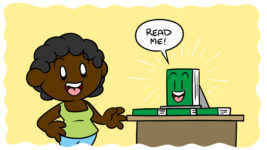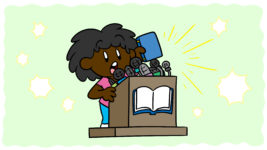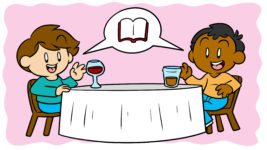Your book has been published, you’ve raked in a few good reviews, and you’re riding high on the success. Not wanting that momentum to taper off, you’ve been thinking about ways to keep the energy going, and you’ve discovered that hosting an author reading is one of the best ways to expand your fan base and connect with new readers.
If you’ve never done this before, it can feel pretty intimidating, but today’s practical how-to will take all the uncertainty out of the equation, effectively handing you a road map for booking – and nailing – your first author reading.
Phase 1: Find a venue
Finding a good host for your first reading isn’t as intimidating as it might sound. Libraries and book stores love hosting events that get people through their doors, so your challenge isn’t persuading them to host an event, just to host your event.
First things first: if you have a publisher, you’ll need to check with them first to see if they have any stipulations. Everything else in this article is subject to any requirements or preferences your publisher may have, so bear that in mind as we proceed.
Next, prepare a list of all possible locations: book stores, libraries, community centers, historical societies, book clubs, schools (if age appropriate), religious centers, and agencies that are prominently represented in your book. Be creative, and begin by listing anybody and everybody. You want to be open-minded during this phase so that you don’t inadvertently exclude anyone before you’ve even considered them. Then, when you have a long and inspiring list, cross off any organizations that would be a stretch.
Prioritize the rest of the list according to the following criteria:
- Is it convenient for you to travel to this location?
- Is the organization known to host book readings or at least other public events?
- How relevant is the location? (Does it feature prominently in your book? Or is it a library, book store, or other site with a vested interest in books?)
- Is the location a popular site for readings and social events? (A small-town library whose last event attracted four patrons may not be your best bet.)
- Does the book store already stock your book? (If the answer to this question is ‘no,’ the store is highly unlikely to host your reading.)
Once you have your ordered list, set a desired date or date range for each potential reading. For most venues, this should be several months out. Some smaller venues may keep a shorter calendar, but it’s best not to assume this. Set the calendar so that if everyone says yes, you’ll be able to accommodate that many readings. Be optimistic and don’t double-book yourself.
The final step in completing your list will be to do some research on each venue. If they’ve hosted readings in the past, find out what books were read and read a sample of each. If they have recordings of the readings, check those out.
If they’ve never hosted a reading before, what events have they hosted? Attend at least one event at each venue if you can. When you’re finished with this phase, you should be able to answer the question ‘What do I have to offer them?’ If there is no answer to this question, you’re not ready to ask them to host you.
Phase 2: Pitch yourself
Your pitch should be different for each venue you approach. Knowing what value your reading will offer to the hosting organization is vital to your pitch. Be careful, though: you don’t want to sound like you’re doing them a favor. This is a mutual exchange. You have something to offer them in exchange for them hosting you.
Respect people’s time; practice a short pitch until you can deliver it smoothly in under two minutes. (One would be better.) If you live nearby, pop in and ask in person. You can use a conversation-friendly version of your book blurb, followed by a single-sentence explanation of why you want to do a reading there. It may be that they’re stocking your book and you’d like to boost sales. If it’s a library, a reading might be a good way to get people in the door. Library readings can be a good way to launch a book-club or book-of-the-month promotion as well. If you’re pitching to a venue that doesn’t typically host readings (community center, religious organization, etc.), you’ll not only need to promote the story as interesting but have a good case for why a reading is a good idea for them in the first place.
Most reading venues will be libraries or book stores. But maybe you wrote a historical novel that features a local synagogue. The research you’ve done on that synagogue and the way you represent it in your writing may be of interest to its members, but you’ll need to say why.
Readings are fun, but everybody knows on some level that the objective is to get people to read – and therefore buy – your book. Try this: to know whether patrons of a certain venue are likely to want to hear about and read your book, imagine a similar book has been written by an author you’ve never heard of about an organization you’re part of. Given how busy your life is, how likely are you to read that book? Now imagine you’re not really a book lover (as will be the case for many non-book-focused organizations). How likely are you to read that book?
If the venue isn’t local, a phone call is better than an email, but an email is better than a voicemail. If you try to reach the right person by phone a couple of times without success, shoot them a quick email and only call again if you don’t hear back.
Phase 3: Prepare the reading
The most important thing you can do to prepare is select the right passage. You don’t want too much dialogue, because ‘he said’ and ‘she said’ grow cumbersome in audible readings. You don’t want too much setting or back story. You don’t want to have to explain too much context.
You do want a self-contained, action-packed passage with one or two power words or phrases – syntactical twists that will light the audience up. If you’re reading at a venue other than a library or book store, look for passages that will resonate with your site-specific audience. That may not be the same passage for every location.
When you’ve identified a few good passages, read them aloud to yourself to see what sounds good. Narrow your choices down to two or three, and read them aloud to a trusted friend who likes reading but has different tastes than you. This is useful because it will help you identify which passages include things that will have value to a mixed audience (e.g. a perfect turn of phrase or a moment that’s intriguing even outside genre context).
When you’ve settled on a passage, practice it until it is virtually memorized. Know that you’re performing, not reading. You should be able to keep your eyes on the audience more often than on the page, only glancing down occasionally to refresh your memory. Your voice should be alive with the tone of the passage. Record yourself (yes, I know, we all hate the sound of our recorded voice). Listen for where you’re going too fast or sound too flat or the sorrowful tone you thought you were projecting sounds whiny. Get feedback from trusted friends, family members, and fellow bibliophiles. Listen to snatches of audiobooks to hear what other readers do well or poorly. Don’t skimp on the practice phase, or you’ll rob yourself of confidence when it’s time for the reading.
Ask your practice listeners for any questions they have about the book. Use their answers and your own critical reasoning skills to anticipate any questions that may come up following the reading. Rehearse your answers, and think about how you could divert some common but boring questions to topics you’d rather discuss.
Well in advance of the reading, ensure that your books will be there on time. This may seem obvious, but it’s an easy detail to overlook if you’re busy securing events, practicing your performance, and managing the rest of your life. Arrange for your books to arrive so far in advance that, if they never arrive at all, you’ll still have time to reorder.
If there won’t be time for a signing following your reading, you might consider signing the books that you’ll have available for sale that day. Ask the venue if they can estimate a turnout. Some places will require registration, which will give you a more exact headcount – but not, of course, well in advance. Have way more books than you think you’ll need.
Find out what the venue will be doing to promote the reading, and plan on doing a healthy amount of marketing yourself. They may put up posters; if they don’t, ask if you can. They may advertise in their newsletter; if they don’t, ask if they will. They may put something on their Facebook page; if they don’t… you get the idea.
Take advantage of every local platform to promote the event, and take advantage of your own platforms as well. Tweet, post, personally invite friends and family and existing fans. If you have postal addresses, you might send paper invitations. In a digital world, these stand out and give your invitation a rightful flair of authenticity. Whoever your lifeline is – spouse, partner, best friend, sibling, parent, writing buddy – make sure they’ll be there. If that person’s presence is important enough, you might think about consulting them during Phase 1 when you settle your potential dates for each venue.
As the reading date approaches, keep practicing. Decide what you’ll wear: comfort and style are both important, but nothing is as important as avoiding anything that will get in the way of a microphone: jangling jewelry, chunky scarves, etc.
If you don’t know what kind of mic you’ll be using, prepare for any eventuality. If it’s a wireless mic, you won’t want to be wearing a watch or bracelets that can interfere with sound. If it’s a headset and you have long hair, wear your hair down or low on your neck, so it will be out of the way. If a clip-on mic, no scarves or necklaces. If a headset, wear something with pockets or a belt so you’ll have a place to clip the unit. You don’t want any surprises to throw you off or frazzle you at the last minute.
Shoes that squeak or clack are a bad idea. Shoes you don’t wear very often are a bad idea. If you’re prone to static, spray your clothes in advance. If you’re prone to sweat, wear dark colors and absorbent fabrics. Wear layers so you have options if the temperature in the room is uncomfortable. If you use reading glasses, know the night before where they are. Don’t wear any fragrances, as they may be off-putting to audience members. Do wear deodorant and brush your teeth. Have a bottle of water at the ready, and take breath mints or spray with you. If you have business cards, get them out and ready. Take some time the day before the reading to lay out everything you’ll want to have with you, so you’re not distracted by preparations before the performance. Consider a personal touch – thank you notes to tuck into the books that you sell or to pass out to attendees, or perhaps if your book mentions a baked good, have some at the reading, especially if you anticipate a small crowd and it won’t stress you out to go the extra mile.
Finally, set your own parameters for success according to the criteria that are within your control. If the turnout is poor because you didn’t promote the event, that’s on you. If you do everything you can to promote and the turnout is poor, let it go. People’s schedules didn’t line up; who knows. If it’s out of your control, don’t count it as an indicator of success. What lies within your control? Performance? Confidence? Preparedness? Marketing? Authentic connection with your audience, regardless of the size? How will you know if your reading was successful or not? Write this down in advance, and bear the answer in mind when the event rolls around. If only six people show up, but your intention was to make a genuine connection with the audience, you can still have a successful event if you don’t allow yourself to be thrown off by circumstances that are outside of your control.
Phase 4: Enjoy the event
If you’ve prepared, you’ve already set yourself up for success, so you should be able to relax on the day itself (or at least focus on what matters). As you go into the reading, there are a few final things you can do to make the experience enjoyable for everyone.
Arrive early. Have your support person or people arrive early. Have everything set up as far in advance as the venue permits, so that you have a few minutes before the reading begins to do whatever it is that relaxes you most: listen to music, chat about something other than the reading with your friends and family, read a book, do a Sudoku, take a quick walk, or drink a cup of tea.
When the reading begins, introduce yourself and your book in two sentences and begin reading. Here’s where your practice pays off. To belay stage fright, focus on the familiarity of the passage, then find one person in the audience and read to them. You’ll want to make eye contact with as many audience members as possible, but you’ll have your point person to return to as an anchor if you feel nervous.
When you’re done, resist the temptation to talk. Close the book and put it down to signal that you’re finished. You’ll have sorted out with the host what happens next, be it a Q&A, a signing, a coffee social, or that’s-it-everybody-go-home. If there’s an MC of sorts, you can simply let them take over. If not, briefly let the audience know what will happen next and thank the venue (and whoever’s in charge) for hosting you. When the formal portion of the event is over, resist the temptation to disappear or latch onto your friends and family. Reach out to as many audience members as you can. Be available, be open, smile a lot, ask people their names and remember them. Pass out business cards or give links to your website, thank people for coming, and ask what they do. This is a chance to network, but that’s hard to do without stepping outside of your comfort zone.
Lather, rinse, repeat
Congratulations: you now know how to find, book, prepare for, and execute your first author reading. This process won’t vary much going forward. Your pitch will change; you’ll become more confident; the process of booking and setting up will become second nature. These readings can be a great way to gain fans, connect with readers, and meet other writers. Most of all, they should be fun. You have the chance to give a living voice to your work – how great is that? If you’re nervous, harness that as energy. Pretend it’s excitement and it will become excitement. Prepare and solicit support, take a deep breath, and have a good time.
Have you done an author reading? What did you learn? If you haven’t done one, will you? Let me know in the comments, and check out Everything You Need To Know About Guerrilla Book Marketing and Literary Fairs Can Help Your Career (Here’s What You Need To Know) for more on organizing a reading.





